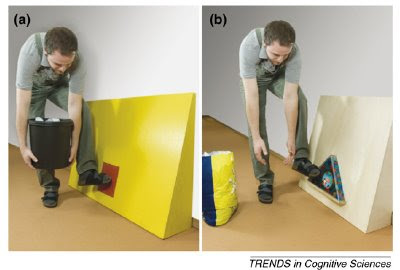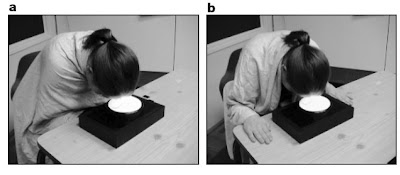In my last post I wrote about two experiments on imitation in young children and chimpanzees by Lyons et al. (2005) and Horner & Whiten (2005). Their results suggested that young children tend to copy both the ‘necessary’ and the ‘unnecessary’ parts of a demonstrator’s action who shows them how to get a reward out of a puzzle box, whereas chimps only copy the ones necessary to get the reward.
![]() One important question raised by these experiments was whether these results can only be applied to wild chimpanzees or whether they also hold for enculturated, human-raised chimps. This is an important question because it is possible that chimpanzees raised in these kinds of richly interactive contexts show more sensitivity to human intentionality.
One important question raised by these experiments was whether these results can only be applied to wild chimpanzees or whether they also hold for enculturated, human-raised chimps. This is an important question because it is possible that chimpanzees raised in these kinds of richly interactive contexts show more sensitivity to human intentionality.
Buttelman et al. (2007) tested just that. They used the “rational imitation” paradigm, which features two conditions
a) the subjects are shown an action in which the specific manner of the action is not purposive and intentional but results from the demonstrator being occupied with something else. For example, he may be carrying something so that he has to use his foot to turn on a light (often called the Hands Occupied Condition).
b) the subjects are shown an action in which the demonstrator chooses a specific manner of doing something on purpose. For example he may have his hands free but still choosto turn on the light with his foot (Hands Free Condition).
taken from Call & Tomasello 2008
Buttelman et al. (2007) based their experimental setup on experiments by Gergely et al. (2002) who tested rational imitation in 14-month-old-infants.
In these experiments, infants saw someone sitting on a chair, with a light-box on a table in front of her. The person sitting in front of the table had a blanket wrapped around her. Now in one condition
a) her hands were occupied (shivering and holding the blanket as if she was cold) and she leaned forward and illuminated the light by pressing down on it with her head.
In the other condition
b) her hands were free and she leaned forward and illuminated the light by pressing down on it with her head.
taken from Gergeley et al. 2002
In the experiment done by Gergeley et al. (2002), most 14-month-old human children re-enacted the demonstrator’s way to illuminate the light in condition b) (Hands Free) but not in condition a) (Hands Occupied).
A probable explanation for this result is that in a) they see the demonstrator as being forced to use her head because her hands are occupied, whereas in b) they see the demonstrator as rationally choosing to illuminate the light with her head, because had she wanted to use her hands, she would’ve done.
They thus encode her performance as causally meaningful and purposive, and re-enact it.
Interestingly, in Buttelman et al’s (2007) study, in both experimental setups presented here, the enculturated chimpanzees also copied
“the demonstrator’s action more often when he freely chose his action than when he was forced to use it by some constraint” (Buttelman et al. 2007: F37).
On a rich interpretation of these results, one could opt for the
“possibility that all great apes possess the ability to understand others’ intentions as rational choices of action plans to achieve goals, but that only some of them are able to show this understanding in these types of experiments due to special attentional or motivational qualities” (Buttelman et al. 2007: F38).
Thus chimpanzees may even have a rudimentary Theory of Mind, which enables them to
“understand others in terms of a perception–goal psychology, as opposed to a full-fledged, human-like belief–desire psychology (Call & Tomasello 2008: 187)
Further Questions:
However, there are still some questions left unanswered. For example, in my previous post I also asked at what point in development human infants start to become sensitive to the goals and intentions of others.
We now know that 14-month-olds imitate rationally, and Schwier et al. (2006) obtained similar results with 12-month-olds in a similar experimental setting. But could there be signs of understanding intentionality even earlier that ?
Another important question is whether human-raised chimpanzees are the only animals able or motivated to imitate rationally. The fact that rearing history has such an important impact on social understanding raises the question whether rational imtation can also be demonstrated in other ‘enculturated’ species, such as dogs.
I will return to these questions in my next post.
References:
Buttelmann D, Carpenter M, Call J, & Tomasello M (2007). Enculturated chimpanzees imitate rationally. Developmental science, 10 (4) PMID: 17552931
Call, Josep, and Michael Tomasello. (2008): Does the chimpanzee have a theory of mind? 30 years later. Trends in Cognitive Sciences 12.5: 187-192. doi:10.1016/j.tics.2008.02.010.
Gergely, Gergely G, Bekkering H, & Király I (2002). Rational imitation in preverbal infants. Nature, 415 (6873) PMID: 11845198
Horner, Victoria, and Andrew Whiten. (2005): Causal knowledge and imitation/emulation switching in chimpanzees (Pan troglodytes) and children (Homo sapiens). Animal Cognition 8.3: 164-81. doi:10.1007/s10071-004-0239-6
Lyons, Derek E., Andrew G. Young, and Frank C. Keil. (2007): The hidden structure of overimitation. Proceedings of the National Academy of Sciences 104, no. 50 (December 11): 19751-19756. doi:10.1073/pnas.0704452104
Schwier, C., van Maanen, C., Carpenter, M., & Tomasello, M.(2006). Rational imitation in 12-month-old infants. Infancy,10, 303–311.
Whiten, Andrew, Victoria Horner & Frans B. M. de Waal. (2005): “Conformity to Cultural Norms of Tool Use in Chimpanzees.” Nature 437: 737-740.



1 thought on “Imitation and Social Cognition in Humans and Chimpanzees (II): Rational Imitation in Human Infants and Human-Raised Chimps”